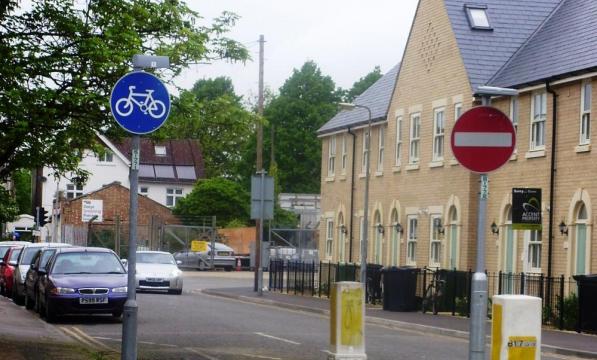Contra-flow cycling (2-way cycling in 1-way streets)
By Cherry

Contra-flow street (Photo: Alasdair Massie)
Headline message
- Allowing cyclists to ride two-way in one-way streets makes cycling in town and cities more convenient by opening up the street network and providing short-cuts. It can also help make cycling safer by offering alternatives to busy roads, and may help stop people riding on the pavement.
- Contra-flow works perfectly safely in many other European countries, where it is already widespread.
- As it gives cycling an advantage over driving, contra-flow helps encourage a shift from cars to cycles for short local journeys.
Important!
Please note: in July 2020, the Department for Transport published new guidance on cycle infrastructure design (LTN1/20). We will be revising all our advice, policy and materials on infrastructure in the light of it as soon as possible. This exercise will include reviewing this page.
Please also note existing cycle infrastructure design guidance for London, Wales and Scotland (revision due). Plus, technical guidance for Local Cycling and Walking Infrastructure Plans (LCWIPs, England).
Policy key facts
Evidence from Belgium suggests that, compared to the road network, the risk of injury is lower in a one-way street with contra-flow cycling or at crossroads including such a street.
Cycling UK view
- One-way systems put cyclists at a disadvantage, making their journeys longer and more stressful. Restoring two-way cycling on one-way streets can significantly improve the safety, convenience and attractiveness of cycling.
- Each local authority should review all its one-way streets, with the aim of progressively converting them either to two-way use (particularly for one-way systems on more major roads), or permitting contra-flow cycling (e.g. on narrower streets), unless it can be demonstrated that there are overriding hazards affecting cyclists.
- Contra-flow cycling should be facilitated through appropriate engineering treatments, depending on the traffic volumes, speeds and road widths involved.
- In many cases, e.g. on quieter roads, unsegregated two-way cycling on an unmarked road is an appropriate solution. More heavily trafficked one-way roads should be provided with contra-flow lanes.
2014-10-31 00:00:00 Europe/London


